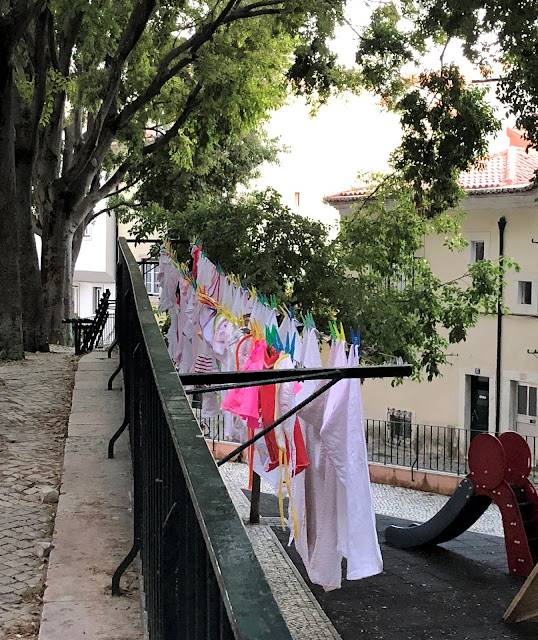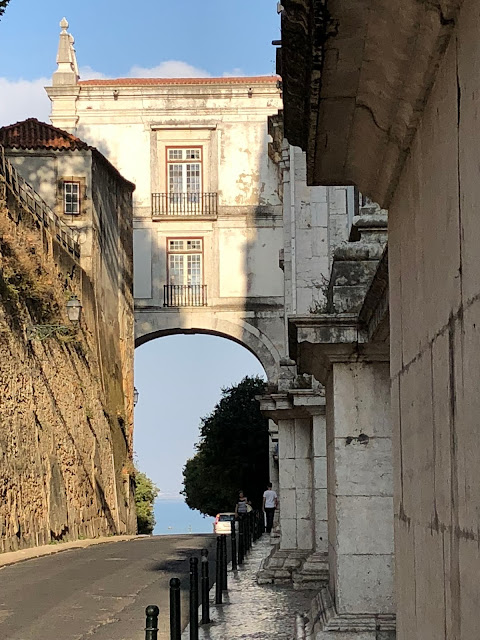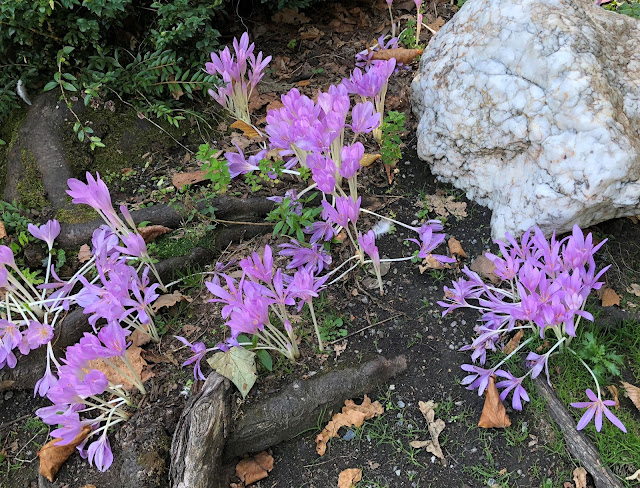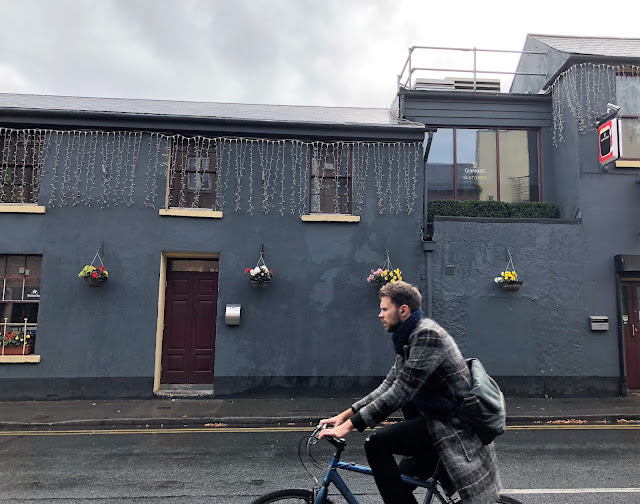We arrived in Lisbon on a beautiful September morning after a long flight. Our rented apartment was in the oldest Lisbon neighborhood - Alfama. The Crooked House apartment in Alfama looked super cute and charming on the website where as in real life the charm was overwhelmed by its ultimate crookedness. When we arrived the place was being cleaned from the previous occupants and we went on a stroll to look around and to get something to eat. A few blocks up from the Crooked House we saw a stunning classic medieval cathedral. It turned out to be the oldest Lisbon Cathedral (12th century). We walked in and were instantly enchanted by the beauty and grandiosity of the old church and I took a few pictures. A half hour later, in a lovely restaurant near Cathedral, I discovered that my wallet had been stolen in the main Lisbon house of God. Lisbon has specialized police department for crimes against tourists and I have an artifact from there as a souvenir from Se Cathedral. With that unfortunate beginning our stay in Lisbon turned out to be stressful, exciting and beautiful at the same time.



Alfama is one of the parts of Lisbon which survived after devastating 1755 earthquake. It is a network of narrow picturesque medieval streets built on the side of steep mountain. Alfama is filled with tourists at all times of the day. Locals, who are mostly relaxed and lazy during siesta hours, turn into enterprising business people at night trying to make the best of the tourist trade. Our Crooked House was across the street from a Fado bar, which came to life at 9 pm every night; the bar’s booster owner, a huge and loud guy, spent his night hours trying to bring customers into his establishment. The spiel about the family business with his mother in the kitchen, his son-in-law behind the bar, his uncle playing guitar and his daughter singing we knew by heart by the second night. The beautiful Fado songs with flamenco and gypsy overtones are so dramatic and emotional that the words are irrelevant – you cry and sing with them. We could hear and see performance right from the window of our apartment in the Crooked House. But by 3 am the singing and drinking party was still on-going and we were somewhat Fado-out and exhausted.

 |
| Fado bar downstairs |















Lisbon tourist trade brought an innovative Times Out market. One of the old central markets was rebuilt to accommodate small kitchens for the city’s best chefs around the perimeter of the building and the middle of the market filled with communal tables. The food is great, the prices are high, the place is buzzing, crowded and exciting. A good lunch experience.





We had a more pleasant dinner in the charming bohemian Café Tati, across the street from the TimeOut market, with live jazz and a spontaneous encounter with a lovely couple from Brazil who had been living in Lisbon for a few years. A lot of laughs and a bottle of organic wine.




We also had a surprising conversation about wine with a waiter. The night before we had dinner in a fancy restaurant and drank a couple glasses of Alvarinho which we loved and we suspected that it is the same wine as our favorite Spanish wine Albarino. Our waiter was particularly friendly, and we asked him if this is the same wine. The waiter immediately lost his smile and said with cool pride in his voice that he knows nothing about Spanish wines. We realized that there is some tension with the big neighbor on their eastern border. And even with a similar language, food and culture, there is a natural rivalry and a striving for identity even though there is no major conflict and a lot of cooperation and trade between them.

A few highlights from our visit include the symbol of Portugal late Gothic Jerónimos Monastery with rope motives in decoration which symbolize and celebrate maritime explorers and the tomb of Vasco da Gama.








We took a short trip to lovely Porto, one of the oldest European cities with amazing bridges, cobblestone medieval streets, steep hills, and beautiful river views. I had one of the best meals of my life in SEMEA restaurant on Rua Das Flores https://portugalconfidential.com/semea-by-euskalduna-vasco-coelho-santos/







n the city former stock exchange (Bolsa do Porto) in this room in 1992 was signed Oporto Treaty for creation European Economic Area

Back in Lisbon, the Gulbenkian Museum contained an amazing collection of art from antiquity to modernity with top of the genre in every time period. Calouste Gulbenkian made his money developing the oil reserves in Middle East. By the end of his life he had become one of the world's wealthiest individuals and his art acquisitions one of the greatest private collections. One of the stars of this amazing collection is a room with best samples of Lallique glass - something special!






The Azulejo - porcelain tile is craft identity of Portugal. The streets of Lisbon and Porto are open air exhibit. The National Azulejo museum located in an old convent houses a beautiful collection of tiles and porcelain from the past five centuries.








Outside of Lisbon a picturesque royal resort town Sintra with magical gardens, parks and fairy-tale castles. While beautiful, the crowds of tourists were a little too much for me.









And Lisbon streets with surreal graffiti, great restaurants, insanely steep, paved with polished marble mosaic, stressful slippery and beautiful. The color of Lisbon is peach.








So here we are – a small beautiful country with rich and dramatic history, beautiful music tradition, and a proud people with strong identity and a bitter rivalry with their larger neighbor.
The sadness of leaving Portugal was relived almost immediately as we arrived in Dublin. Dublin met us with surprisingly sunny day and a very comfortable old hotel remodeled from an even older schoolhouse.

We stopped for lunch in the first open bar; being Sunday, most places were closed. As I went downstairs to the bathroom, I heard beautiful male choir. The bar had a downstairs room where 5-6 older guys were drinking beer and singing together in the middle of a Sunday afternoon just for fun. What a joy!
The sunny days don’t last for long in Dublin; the clouds and rain came back fast. But the stereotype about Ireland being an emerald island is overused and therefore doesn’t describe the meaning of Irish green. In Lisbon the light is coming from the bright blue sky, in Dublin it is coming from greenery in the parks and flowers everywhere.





The Irish people are super friendly, not in the somewhat artificial American way, but rather authentic and sincere. They are also obsessed with their history of fighting for their independence from Great Britain and this struggle against an imperial neighbor became the most important part of their identity.
The Little Dublin Museum has an amazing tour with guides who are very knowledgeable and entertaining. They lead you through an old townhouse filled with countless artifacts about Irish life and struggle under British control.



The National Art Museum has a respectable collection of European art and the best collection of Irish artists who are mostly unknown outside of Ireland. The Irish artists well represented by old masters and modern pieces. While talking pictures is prohibited and strictly enforced in the Irish section of museum (I only have few), the remaining collection is free to photograph including a lovely and priceless Vermeer.






The brother of great Irish poet William Butler Yeats is best known 20th century Irish painter John Butler Yeats

One of Dublin’s main sites is Trinity College; one of the oldest colleges in Europe and home of the 9th-century gospel manuscript Book of Kells and the Irish Harp. The main chamber of the Old Library is the Long Room; at nearly 65 meters long, it is filled with 200,000 of the Library’s oldest books and is one of the most impressive libraries in the world.




Ireland has an amazing literary heritage and many writers which we get used to think as English were actually Irish. It is probably not a news to many, but I was surprised to learn that Oscar Wilde was born in Dublin. The house where Oscar Wilde was born is located across the street from Merrion square, where relatively recently (1993) Oscar Wilde Memorial Sculpture was installed.



The old pharmacy where Leopold Bloom from Joyce’s Ulysses used to buy lemon soap hosts daily James Joyce readings organized by the small team of volunteers. After reading participants go to the pub next door to discuss Joyce’s writing. The pub is located on the first floor of Lincoln Inn formerly Finn's Hotel. In 1904 James Joyce first met Nora Barnacle as she was on her way from Finn’s Hotel. Nora was working as a barmaid in the hotel when Joyce met her.







Dublin’s streets are insanely lovely and beautiful, with rows of Georgian period buildings austerely looking at the parks with amazing greenery. The Dublin color is emerald














So here we are – small beautiful country with rich and dramatic history, beautiful music tradition, and proud people with strong identity and bitter rivalry with a big neighbor next door.
